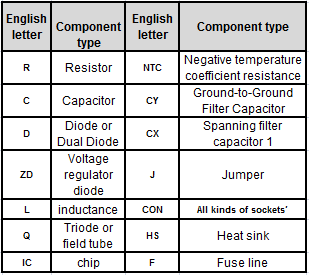How to recognize ATX Power supply and maintenance Instruments
1. Recognize the ATX power supply through the identification on the circuit board.
Like most boards, the ATX power board is usually marked with a silk print near the component. The screen print consists of "letter + number" two parts: the English letter represents the type of element, and the number represents its sequence number in the whole circuit.
Table 1 shows the correspondence between the English letter and the type of component it represents.

Table 1. The English letter and the type of component it represents.
2. Learn from the running line that the ATX power
Standard ATX power board is usually a circuit board with a length of 145mm long and a 110mm width.
Although the ATX power supply is more complex, both the ruler of the components installed on the front of the circuit board and the printed circuit wiring on the back of the circuit board are relatively large and wide. In the case of the use of magnifying glasses, it is possible to identify the surface type of the element and the origin of the wiring.
In other words, even in the absence of a specific ATX power supply drawing, the interconnecting relationship between all components on the circuit board should be clearly defined by a combination of naked eye observation and a multimeter. If necessary, the whole circuit diagram can even be drawn by hand. This process, commonly referred to as "running the track", that is, "running the line".
Readers who have had maintenance experience should know that running the line is a time-consuming and laborious task. For beginners, it is often caught in a dilemma: although pre-repair theoretical preparations have been completed through the interpretation of some ATX power drawing and other technical data, it still feels like it is impossible to do so in the face of a real fault with the ATX power supply.
This is because the drawings and other technical data are general, but also indirect, which inevitably omits too many process details, especially the lack of perceptual knowledge of the ATX power supply. In other words, in order to truly achieve the level of chip-level maintenance, in addition to the necessary theoretical basis, we also need to have a fairly strong sense of the ATX power supply. The running line is exactly the practical process of transforming the theoretical knowledge into the practical maintenance ability of the beginners. For beginners, in order to truly grasp the composition of each circuit of ATX power supply, it is necessary to go through this practical process to put forward a valuable question about the working principle of the circuit.
To sum up, running as an important skill required for maintenance is indispensable and must not be ignored.

